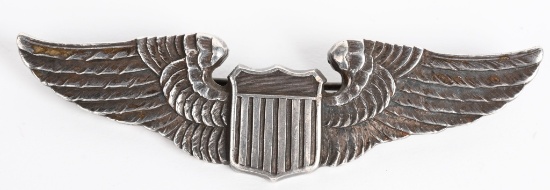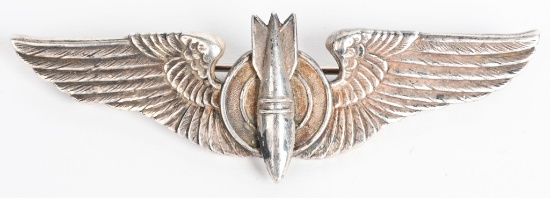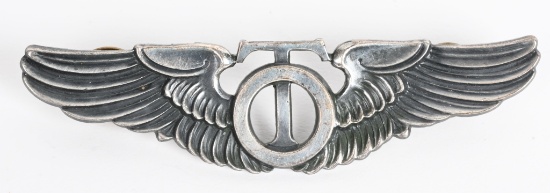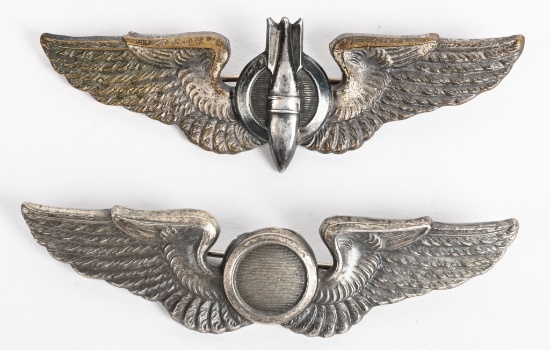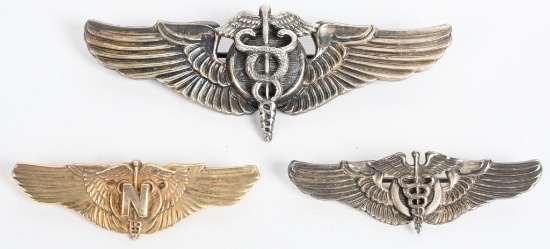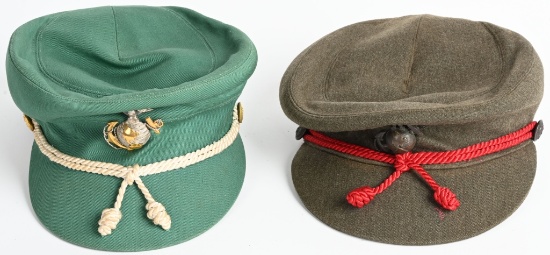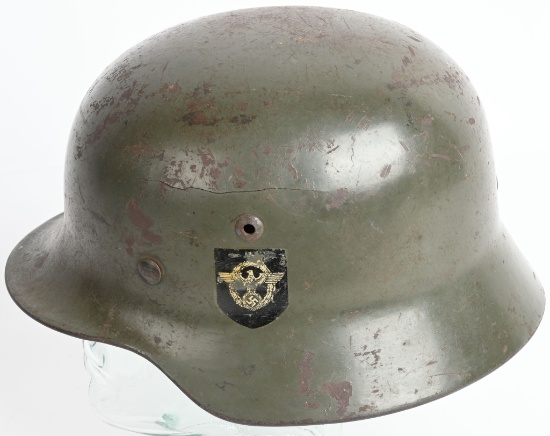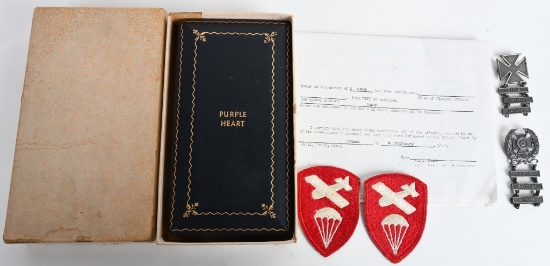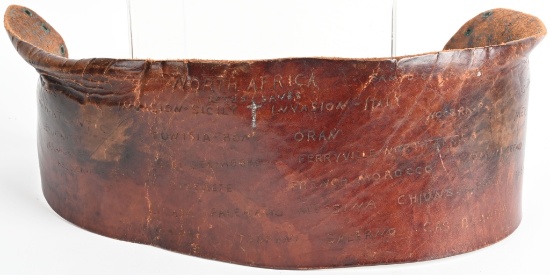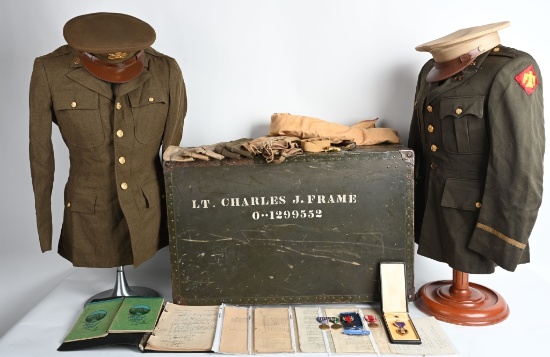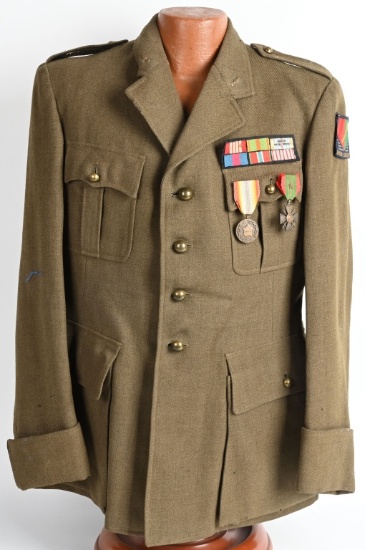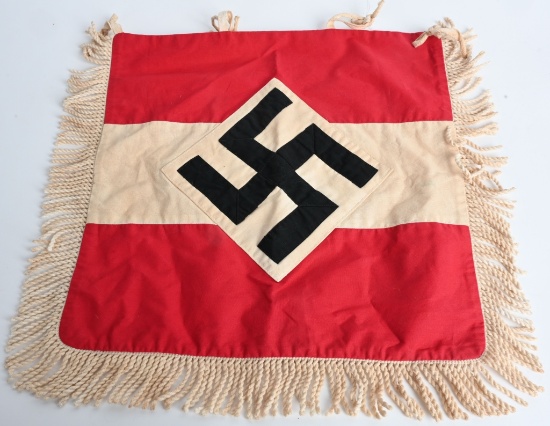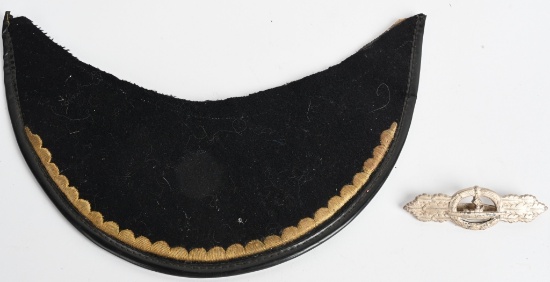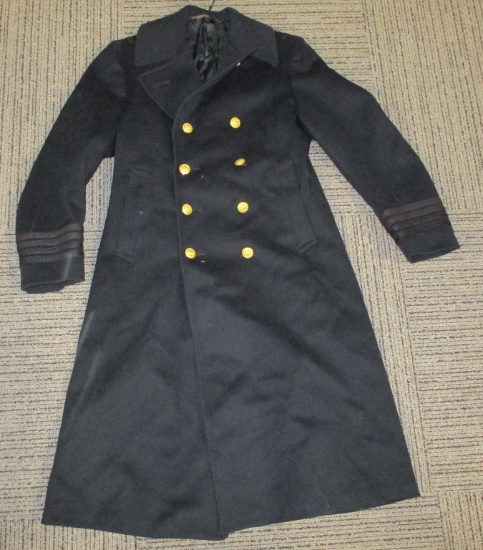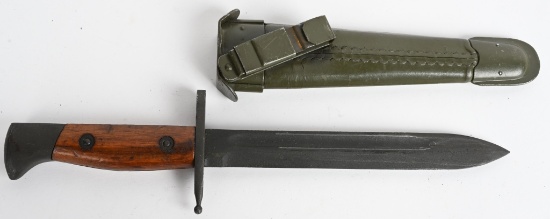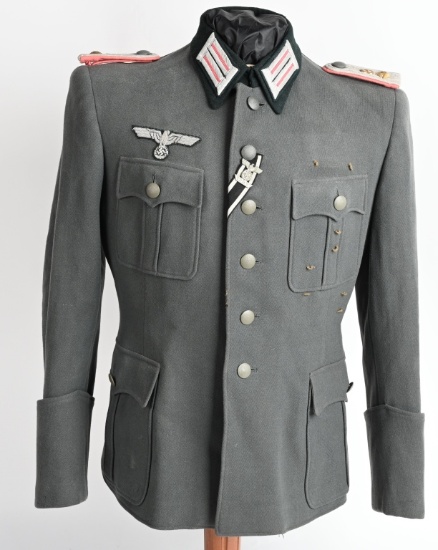
PREMIER MILITARIA & EDGED WEAPONS AUCTION

PREMIER MILITARIA & EDGED WEAPONS AUCTION
See Special Terms for additional fees
Cash Payment Discount: 3%
Description
PROUDLY PRESENTS
PREMIER MILITARIA & EDGED WEAPON AUCTION
OVER 700 LOTS OF MILITARIA FROM THE 18TH TO THE 20TH CENTURY. MORE THAN 25 LOTS of CIVIL WAR INCLUDING SWORDS, ACCOUNTREMENTS, IMAGES and MORE, INCLUDING AN IDENTIFIED CONFEDERATE POW'S SHELL JACKET;
WW1 and WW2 US GROUPINGS, EDGED WEAPONS, HELMETS, MEDALS, FLAGS, UNIFORMS, INSIGNIA, PATRIOTIC POSTERS and MORE INCLUDING MERRILL'S MARAUDERS GROUPING, NAMED MEDAL GROUPINGS, PAINTED COMBAT HELMETS, AND MORE. 30 PLUS LOTS of IMPERIAL GERMAN SWORDS, HEAD GEAR, MEDALS and MORE. 400 PLUS LOTS of WW2 NAZI GERMAN ITEMS INCLUDING a TRANSITIONAL WAFFEN SS HELMET, NAZI GERMAN ORG. TODT UNIFORM, NAZI GERMAN DIPLOMAT DAGGER, BADGES, MEDALS, INSIGNIA, HELMETS, UNIFORMS, SWORDS, BAYONETS, ACCOUTREMENTS, NSDAP PARTY UNIFORMS and MUCH MUCH MORE! JAPANESE ITEMS INCLUDING A PARATROOPER PARACHUTE, JAPANESE KATANA SWORDS, TANTOS, FLAGS, MEDALS, BADGES and MORE. KOREAN AND VIETNAM WAR LOTS, INERT ORDNANCE COLLECTION INCLUDING AN E1R1 FLAMETHROWER, INERT RPG, INERT MORTARS, INERT... Show more Show Less
Cash Payment Discount: 3%
Participation Requirements: Valid Credit Card required for bidding approval
Payment Options: Visa, MasterCard, Discover, American Express, Check, Money Order, and Wire Transfer
Visa MasterCard Discover American Express
Payment Instructions: SALES TAX All buyers will pay applicable state sales tax. Sales tax is require if mandated by the state you reside in for all internet sales and will be added to your invoice. If buyer provides a current state exemption form there will be no sales tax added. PAYMENT All merchandise must be paid in full within ten (10) days of the date of the sale. Purchases totaling $20,000 or more must be paid within three (3) days of the date of the sale. Call 440-527-8060 to pay your invoice by phone or mail payment to: 38198 Willoughby Parkway, Willoughby Ohio, 44094. Absentee bids placed through www.milestoneauctions.com and Proxibid.com will be auto charged to the credit card entered 48 hours after the end of the sale. If you wish to pay by another method please contact us within 48 hours after the sale. We accept Visa, MasterCard, Discover, personal checks/ certified checks, wire transfer, money orders, and cash. CREDIT CARD - For first time buyers and credit card charges greater than $2,500.00 buyers must complete the bottom portion of the invoice and must specifically sign the acknowledgement of our terms of sale before we will accept payment via credit card. We do offer the convenience of paying automatically by credit card. If you wish have your card automatically charged for all purchases please complete our Authorization for Automatic Credit Card Use. We have this form available upon request. Split payments are subject to a 23% buyer premium if a credit card is used as any form of total payment. CHECK - There will be a $30.00 service charge for returned checks. Make checks payable to: Milestone Auctions LLC. Milestone Auctions reserves the right to hold items paid for by personal or company check until said check clears (14 days). Milestone Auctions has the right to hold all checks over $2,000.00. Customers who have an established successful buying In the few situations where a successful bidder does not remit payment when due, Milestone Auctions will proceed with the legal steps necessary to protect its interests and will block the bidder from future auction participation.
Currency Type: USD
Shipping Instructions: Please see our terms and conditions.
Preview Date & Times: Items are available for preview 7 days prior to the sale by appointment. Auction day preview is February 13th at 8AM.
Checkout Date & Times: Please contact the auction company for checkout dates & times.
Location: 38198 Willoughby Parkway, Willoughby, OH 44094
Driving Directions:

By clicking "Confirm Buy" you are agreeing to the terms of the sale. Instant Purchase items may have additional fees such as an Internet Premium, Sales Tax, Shipping or other fees not included in the Instant Purchase price. Please see Auction Information for full details.
Payment Type:
WWII US ARMY AIR CORPS PILOT WINGS BY LUXENBERG
Lot # 491 (Sale Order: 551 of 784)
WWII US AIR CORPS BOMBARDIER WINGS BY LUXENBERG
Lot # 492 (Sale Order: 552 of 784)
WWII US ARMY TECHNICAL OBSERVER PILOT WINGS WW2
Lot # 493 (Sale Order: 553 of 784)
WWII PILOT OBSERVER BOMBARDIER WINGS ENLISG MADE
Lot # 494 (Sale Order: 554 of 784)
WWII US ARMY AIR CORPS FLIGHT NURSE SURGEON WINGS
Lot # 495 (Sale Order: 555 of 784)
WWII US MARINE CORPS WOMEN'S RESERVE OFFICER VISOR
Lot # 496 (Sale Order: 556 of 784)
WWII NAZI GERMAN M35 DOUBLE DECAL POLIZEI HELMET
Lot # 497 (Sale Order: 557 of 784)
WWII US ARMY 508th 82nd AIRBORNE PURPLE HEART KIA
Lot # 498 (Sale Order: 558 of 784)
NAMED NASA FLIGHT SUIT & MEDALS SPACE SHUTTLE 51-C
Lot # 499 (Sale Order: 559 of 784)
WWII PAINTED A2 FLIGHT JACKET GROUPING W/ PATCHES
Lot # 500 (Sale Order: 560 of 784)
WWII US 1st RANGER BATTALION ID'ed LEATHER BRACE
Lot # 500a (Sale Order: 561 of 784)
WWII 45TH DIVISION KIA OFFICER TRUNK GROUPING
Lot # 501 (Sale Order: 562 of 784)
WWII NUMBERED DSC MEDAL W WRAPPED BROOCH 13998
Lot # 501a (Sale Order: 563 of 784)
WWII NAZI GERMAN PARATROOPER GRAVITY KNIFE WW2
Lot # 502 (Sale Order: 564 of 784)
WWII US ARMY AIR CORPS 491ST BG A2 FLIGHT JACKET
Lot # 503 (Sale Order: 565 of 784)
WW2 BRITISH FAIRBAIRN/SYKES FIGHTING KNIFE SHEATH
Lot # 504 (Sale Order: 566 of 784)
CANADIAN GENERAL BATTLEDRESS JACKET WITH INSIGNIA
Lot # 504a (Sale Order: 567 of 784)
WWII FREE FRENCH 1ST ARMY POW UNIFORM JACKET
Lot # 504b (Sale Order: 568 of 784)
WWII NAZI GERMAN HJ FANFARE TRUMPET BANNER WW2
Lot # 505 (Sale Order: 569 of 784)
WWII NAZI GERMAN U-BOAT COMBAT CLASP & VISOR WW2
Lot # 506 (Sale Order: 570 of 784)
WWII US NAVY REAR ADMIRAL NAMED OVERCOAT TO HERO
Lot # 507 (Sale Order: 571 of 784)
WWII MARINE RAIDER FIGHTING KNIFE GROUPING ID'ed
Lot # 508 (Sale Order: 572 of 784)
WWII KRAG RIFLE NORWEGIAN BAYONET & SCABBARD
Lot # 509 (Sale Order: 573 of 784)
WWII NAZI & NORWEGIAN MILITARY KRAG RIFLE BAYONET
Lot # 510 (Sale Order: 574 of 784)
ITALIAN FIGHTING KNIFE ASSALTATORI ASSAULT TROOPS
Lot # 511 (Sale Order: 575 of 784)
| Bid Range | Increment |
| $0.00 - $299.99 | $10.00 |
| $300.00 - $999.99 | $25.00 |
| $1,000.00 - $1,999.99 | $50.00 |
| $2,000.00 - $4,999.99 | $100.00 |
| $5,000.00 - $9,999.99 | $250.00 |
| $10,000.00 - $24,999.99 | $500.00 |
| $25,000.00 - $49,999.99 | $1,000.00 |
| $50,000.00 - $99,999.99 | $2,500.00 |
| $100,000.00+ | $5,000.00 |

 x Cancel
x Cancel